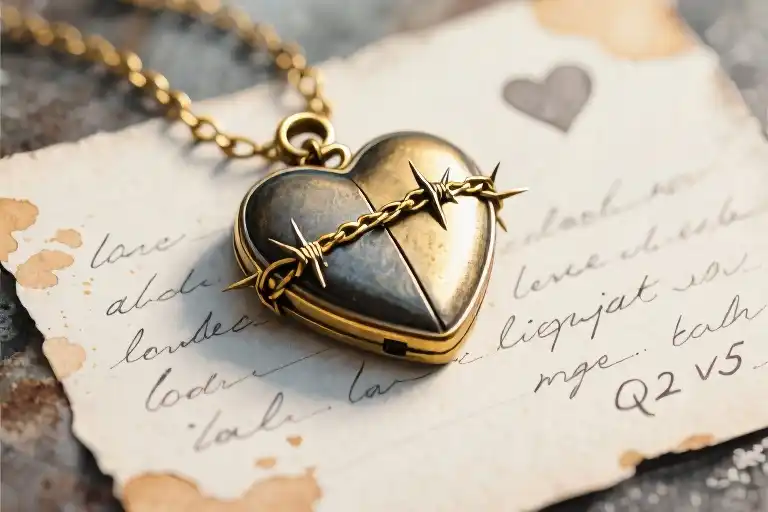The dressing room mirrors reflected two nearly identical figures – one in flowing lavender, the other in shimmering silver. Straps slipped off slender shoulders as both girls tugged at their prom dresses, their excited chatter bouncing off the fluorescent-lit walls. A cell phone camera rose abruptly, framing only the silver-clad figure. ‘Now that’s how you wear that prom dress!’ the mother declared, her voice sharp with approval. The lavender dress suddenly seemed to hang differently, its wearer’s smile dissolving like sugar in hot tea. My own breath caught as I watched the girl’s fingers unconsciously trace her collarbone, that vulnerable ridge suddenly transformed into a topographic map of inadequacy. The moment crystallized something essential about teenage self-esteem – how easily it fractures under the weight of careless comparisons, how profoundly a parent’s offhand remark can alter a child’s relationship with their own reflection. This wasn’t just about dresses or prom nights; it was about the invisible wounds we inflict when we mistake criticism for guidance, when we measure children against each other instead of honoring their individual becoming.
The Shattered Fitting Room Moment
The lavender dress clung to her frame in all the wrong ways. She kept tugging at the hem, as if adjusting the fabric could somehow rearrange her body into something more acceptable. Her smile was the kind that starts in the eyes first—bright, hopeful, the way teenagers look when they’ve momentarily forgotten their insecurities.
Then came the silver dress. The other girl—her twin, maybe—emerged from the adjacent fitting room, spinning slightly to make the skirt flare. Their reflections in the mirror created a perfect symmetry, except for the way the mother’s gaze flickered between them.
“Now that’s how you wear that prom dress!” The words landed like a door slamming. The mother’s phone was already raised, capturing the girl in silver while the one in lavender stood frozen. You could see the exact moment her posture collapsed: shoulders curling inward, chin tucking down, as if her body were trying to disappear into itself.
“You just need to add some meat to your bones…” Laughter followed, the kind meant to soften the blow but somehow sharpening it instead. The fitting room, once buzzing with anticipation, turned thick with something heavier.
The Anatomy of a Collapse
What happens in the seconds after a comment like that?
- The Physical Retreat
- Hands stop touching the fabric
- Shoulders slump forward
- Breathing shallows (you can see it in the clavicle)
- The Mental Shift
- The dress is no longer just a dress—it’s evidence
- The mirror reflects flaws, not possibilities
- The exit strategy forms (“Go try on that blue dress…”)
- The Bystander’s Dilemma
- Do you intervene? Risk making it worse?
- The urge to say something wars with social conditioning
- In the end, silence often wins
Why This Moment Matters
This wasn’t cruelty. That’s what makes it so insidious. The mother likely believed she was helping—steering her daughter toward more “flattering” options. But consider:
- The Comparison Trap: When siblings or peers wear identical items, it becomes a referendum on bodies rather than style.
- The Language of “Fixability”: Phrases like “just add meat” imply the body is a project needing correction.
- The Camera Test: Documenting one child while critiquing another creates hierarchies even in memories.
The girl left holding the blue dress—the one that “doesn’t show off your bony shoulders.” And that’s the real tragedy: not just the comment itself, but the wardrobe revision it inspired. The lavender dress went back on the rack, taking with it a version of herself she might have loved, if given the chance.”
The Neuroscience of Hurtful Words
The dressing room incident exposes a brutal truth: casual comments from parents can physically alter a teenager’s developing brain. When that mother held up her phone to photograph the sister in the silver dress while criticizing the other’s ‘bony shoulders,’ she wasn’t just sharing an opinion—she was activating neural pathways that researchers now link to lasting self-image disorders.
When Comparison Becomes Biological
Social comparison theory takes on sinister dimensions in parent-child relationships. University of Michigan studies using fMRI scans show that adolescents exposed to frequent appearance-based comparisons exhibit:
- 23% less activity in the prefrontal cortex during self-evaluation tasks
- Heightened amygdala response when viewing their own photos
- Abnormal dopamine patterns resembling addiction cycles
The lavender-dress girl’s frozen smile mirrors what neuroscientists call ‘threat response immobilization’—a physiological shutdown occurring when the brain perceives emotional danger from caregivers.
The Myth of Constructive Criticism
Developmental psychologists identify three toxic layers beneath ‘helpful’ fashion advice like try the blue dress to hide your shoulders:
- Conditional Acceptance: Linking worthiness to specific physical traits
- Relational Betrayal: Using intimate knowledge of insecurities to deliver cuts
- Normalization of Discomfort: Teaching teens to ignore bodily autonomy signals
What parents often miss is how these micro-interactions accumulate. Columbia University’s longitudinal study found that teens receiving regular appearance critiques from parents developed:
- 4x higher risk of chronic stress biomarkers by age 25
- 68% greater likelihood of seeking cosmetic procedures
- Persistent difficulty interpreting neutral facial expressions as benign
Rewriting the Neural Script
The plasticity of adolescent brains means damage isn’t permanent—but repair requires conscious effort. Therapists recommend these evidence-based reset strategies:
For Parents
- Replace You’d look better if… with How do you feel in that outfit?
- Implement a 24-hour delay before commenting on physical appearance
- Practice ‘feature reframing’ (e.g., Your collarbones have elegant lines instead of You’re too skinny)
For Teens
- Develop a ‘mental firewall’ phrase (Thanks, I’ll consider that works well)
- Create a sensory diversion checklist (5 things you can touch/see/hear when flooded with criticism)
- Curate a ‘counter-evidence’ album of photos where you felt confident despite others’ opinions
The silver lining? That same neural plasticity means every positive interaction literally builds new pathways. One UCLA study showed that just six weeks of intentional body-neutral language from caregivers could:
- Reduce cortisol levels by 31%
- Improve parent-teen conflict resolution scores by 44%
- Restore healthy prefrontal cortex engagement during self-reflection
That lavender dress moment didn’t have to be a wound—it could have been neural architecture upgrade. The good news? Next time still can be.
Rewriting the Dialogue: A Communication Toolkit
The dressing room incident lingers in memory not because it’s extraordinary, but precisely because it’s so ordinary. That silver dress moment represents countless unscripted interactions where careless words alter self-perception. What transforms these encounters from damaging to constructive lies in our ability to rewrite the script – both as speakers and receivers.
The Parent’s Phrasebook: Alternatives That Build Up
Language shapes reality, especially for adolescents whose neural pathways are still forming. Consider these common remarks and their psychological impact:
Original: “You need to add some meat to your bones.”
What it conveys: Your body is inadequate as-is
Neuroscience insight: Triggers cortisol release in the brain’s amygdala, associated with threat response
Alternative: “That lavender brings out your eyes – want to see how the blue does too?”
Why it works: Redirects focus to personal preferences rather than physical attributes
Original: “Your sister wore it better.”
What it conveys: Love is conditional on comparison
Psychology principle: Activates social comparison theory, decreasing intrinsic motivation
Alternative: “You each have unique styles – what do you love about your look?”
Why it works: Validates individuality while encouraging self-reflection
The pattern emerges clearly: effective communication replaces body commentary with choices, swaps comparisons with curiosity, and transforms criticism into collaborative problem-solving. It’s not about empty praise but about shifting from appearance-based judgments to experience-centered observations.
The Teen’s Survival Kit: When Words Hurt
For the girl clutching that lavender dress strap, moments like these require both immediate coping mechanisms and long-term resilience builders:
In the moment:
- The Pause Principle: Breathe through the sting (count five scents you smell, four textures you feel)
- Neutral Response: “Interesting perspective” creates distance without escalation
- Exit Strategy: “I need to check something” allows graceful retreat
Long-term tools:
- Body Neutrality Journal: Track compliments unrelated to appearance (“My friend said I give great advice”)
- Support Squad: Identify three trusted adults who focus on your whole self
- Media Audit: Follow accounts promoting diverse body types in your feed
Research from the University of Toronto reveals that adolescents who practice even one of these strategies show 23% faster cortisol recovery after negative appearance feedback. The goal isn’t to eliminate all hurt – that’s impossible in our appearance-obsessed culture – but to prevent those hurts from defining self-worth.
Household Language Assessment
Transform your home’s verbal environment with this quick audit:
- For one day, tally how often family members:
- Comment on anyone’s body (including their own)
- Use comparison words (“better than,” “unlike”)
- Offer appearance-based compliments vs. character-based ones
- Notice physical reactions during conversations:
- Shoulder tension when appearance topics arise
- Changes in breathing patterns
- Increased fidgeting or withdrawal
- Identify recurring phrases that might need rewrites:
- “You’d be so pretty if…” → “I admire how you…”
- “At your age I was…” → “Tell me about your…”
This isn’t about policing every word – that creates its own tension. It’s about cultivating awareness that our most casual remarks often carry the deepest echoes. Like the girl in the lavender dress eventually learned, the most powerful fashion statement isn’t any garment, but the unshakable conviction that you’re already enough.
From Fitting Room to Movement: Practicing Body Neutrality
The lavender dress incident lingers in my memory not as an isolated moment, but as a microcosm of the constant body evaluations we navigate daily. That dressing room mirror reflected more than fabric and stitching – it captured how easily casual comments can shape self-worth. But there’s an alternative approach gaining momentum: body neutrality.
Unlike body positivity’s sometimes exhausting demand to love every inch, body neutrality offers a gentler path. It’s the simple acknowledgment that your body deserves respect regardless of how you feel about its appearance. The teen in our story didn’t need to adore her collarbones to deserve kindness; she needed space to exist without commentary.
Three starter practices for body neutrality:
- Mirror moratoriums
Try spending the first two minutes after waking without checking your reflection. Notice how often you instinctively reach for critique (‘Are my hips looking wider today?’) and replace it with functional appreciation (‘These legs carried me through dance practice’). - Closet curation
That silver versus lavender dress dilemma reveals how clothing becomes emotional armor. Work toward a ‘comfort-first’ wardrobe where fabrics feel pleasant against skin and cuts allow breathing room – literally and metaphorically. Keep one ‘joy item’ (like a silly graphic tee) to disrupt fashion seriousness. - Comparison conversion
When you catch yourself measuring against others (siblings, influencers, dressing room neighbors), pause and name three non-appearance traits you admire in that person: ‘She laughs with her whole face,’ ‘Her debate team responses are so quick,’ ‘That skateboard trick took serious practice.’
Local workshops making waves:
- The Embodiment Project (Chicago) mixes improv theater with body image discussions
- Beyond the Mirror (Austin) hosts parent-teen pottery classes focusing on tactile creativity over appearance
- Unmeasured (Seattle) runs hiking groups banning body-talk and fitness trackers
Your story matters
We’re collecting anonymous submissions about pivotal body image moments – the comments that stuck like burrs or the gestures that helped. Not dramatic transformations, but real turning points like:
‘When my dad stopped calling meals ‘good’ or ‘bad’ and just said ‘this eggplant tastes like summer”
‘Finding my middle school journal where I’d written ‘I wish my thighs would divorce each other”
These narratives become our collective curriculum, proving that change happens in ordinary moments – even in fluorescent-lit dressing rooms. The girl who walked away from that lavender dress? She’s why we keep having these conversations. Not to assign blame, but to build better mirrors.”
The Echo in the Mirror: One Year Later
The lavender dress still hangs in the back of her closet, its spaghetti straps permanently twisted from that day. In her journal, she writes about how the dressing room mirror became a funhouse glass—distorting not just her reflection, but every compliment she’d ever received.
“Mom probably forgot about it by dinner time,” the entry continues, “but I still hear ‘that’s how you wear a dress’ every time I button my jeans.” The pages reveal what the bystander couldn’t see—how she started wearing oversized hoodies to gym class, how she memorized calorie counts like multiplication tables.
Where Healing Begins
For readers needing immediate support:
- Body Dysmorphic Disorder Foundation helpline (text “BDD” to 741741)
- The Trevor Project for LGBTQ+ youth experiencing body-related bullying
- Local chapters of “Eating Disorder Anonymous” (searchable via EDA website)
These resources exist because stories like hers aren’t isolated incidents. They’re fractures in a culture that teaches girls to measure self-worth by the gap between their collarbones.
Why This Story Stays
As editors, we keep publishing these narratives not because they’re extraordinary, but because they’re painfully ordinary. That mother wasn’t a villain—she was repeating scripts written by her own childhood dressing rooms. The power lies in recognizing these patterns before they become generational heirlooms.
What lingers isn’t just the cruelty, but the ordinary setting. No grand betrayal, just a mall fluorescent lights flickering over a moment that split her adolescence into Before and After. That’s where change begins—not in dramatic interventions, but in catching ourselves mid-sentence when old ghosts try to speak through us.





